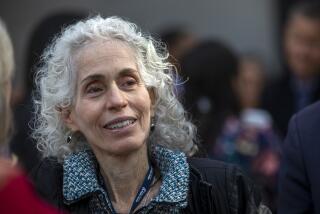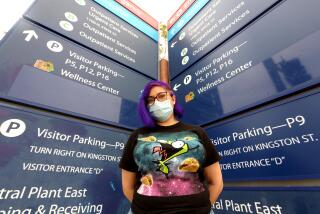Health Experts Say Dangers Cross Social Boundaries
- Share via
The poor will suffer immediately if deep cuts in Los Angeles County’s health budget are imposed, but the middle class and wealthy are likely to be hurt eventually as emergency rooms close, contagious diseases spread and children with birth defects become taxpayer burdens, public-health experts say.
“A bacterium doesn’t know if you live in Beverly Hills in a $4-million house or in East L.A.,” said Dr. F. Douglas Scutchfield, who heads San Diego State’s graduate school of public health.
Facing an unprecedented budget deficit, county officials plan to shut down about three-quarters of their 45 public-health clinics Oct. 1 and possibly close up to four of six county hospitals unless they are financially rescued by the state and federal governments. On Friday, nearly 5,200 county health workers--from doctors and nurses to cooks and plumbers--were notified that they will lose their jobs or be demoted.
Hundred of thousands of poor people a year receive medical attention at county clinics, and experts say eliminating so many of them will severely reduce access to vital prenatal care, AIDS testing and treatment of other infectious diseases such as tuberculosis and syphilis.
Denied access to routine and preventive care, many low-income people will get seriously ill, as treatable diseases turn life-threatening. And as surviving county facilities become overloaded, experts say, large numbers of the poor are likely to spill over into the private hospital system, affecting care for other socioeconomic classes.
“Somehow I don’t think the Westside, and the north side, appreciate the impact of this on them,” said Dr. Michael Ross, a UCLA medical school professor and chief of obstetrics at Harbor-UCLA Medical Center.
With clinics closed, the ailing poor will go to the nearest hospital emergency room, public or private. A large influx of patients who cannot pay their bills, authorities predict, will prompt some hospitals to close their ERs, leaving ambulances to hunt for open facilities that may be many miles away.
Although federal law requires emergency room physicians to stabilize injured people regardless of their ability to pay, many on-call doctors who provide specialized treatment such as neurosurgery are likely to refuse to show up at hospitals if it means losing substantial income on uninsured patients, authorities say.
“We can’t force our doctors to take calls,” said Dr. Jorge Diaz, co-director of emergency care at Santa Marta Hospital, a small Catholic institution in East Los Angeles.
With on-call physicians failing to respond, experts say, hospitals will have no choice but to shut down emergency rooms.
“Emergency rooms serve everybody . . . rich, poor, tall, short,” said Dr. Franklin Pratt, co-director of the emergency department at Torrance Memorial Medical Center. “A closed emergency room is closed for everybody.”
Public-health specialists said smaller hospitals in low-income areas of the Eastside and South Los Angeles are most likely to close their emergency rooms first, forcing ambulance crews to drive as far as the San Fernando and San Gabriel valleys.
“They’re going to go up to 40 minutes [driving time],” said Mike Pfeiffer, executive director of the Los Angeles County Emergency Medical Directors Assn. “That’s a long way. A terribly long way. We hope it won’t happen. But anything is possible if emergency departments start filling up with patients.”
Experts also fear that planned reductions in prenatal services will produce a jump in birth defects. More than 27,000 babies are born each year at county hospitals.
Although six clinics in the San Fernando and Santa Clarita valleys now provide well-baby education, treatment of pregnancy-related diabetes and other prenatal care, only one of those is scheduled to remain open following the cuts.
With less access to prenatal care, women are more likely to deliver babies at greater risk for severe defects as a result of rubella, sexually transmitted diseases and drug and alcohol use, experts say. An infant requiring prolonged intensive care can cost taxpayers hundreds of thousands of dollars, and more as they grow older.
Dr. Irwin Silberman, director of family health programs for the county, said things may not be as bleak as some fear. Many pregnant low-income women, for instance, will be able to find private physicians because the women are covered by Medi-Cal, the state’s insurance program for the needy, he said.
He added that county officials also are urging private hospitals and physician groups that want to take over county clinics to continue offering prenatal services. Dozens of private care-givers are bidding to assume management of the facilities in a privatization move.
However, about two-thirds of all county patients are uninsured, and Silberman acknowledged that many of them will not be able to get prenatal care.
Public health experts warn that clinic reductions and other cuts also could trigger a resurgence in contagious diseases.
Dr. Shirley Fannin, the county’s communicable disease-control chief, said that although the county now offers treatment for tuberculosis and sexually transmitted diseases at 39 clinics, it will offer them at only 10 following the scheduled cuts.
“That’s not enough for 9 million people,” she said. “What can we expect out of this? We can expect that we are going to miss [diagnosing and treating] a whole lot of disease.”
Since infectious diseases observe no geographic or class boundaries, she said, people in more affluent parts of the county will be at risk, as well as those in other areas.
“They may have gated communities, but they still have to go out and about in their commerce in this community,” said Fannin. “We’re just all in it together, whether we want to believe that or not.”
Dr. Ellen Alkon, medical director for eight county health centers in Long Beach and the South Bay area, said only one will remain open after the planned cuts. Immunizations and treatment of tuberculosis and sexually transmitted diseases will continue at that clinic. But with reduced access to care for other infectious diseases, she said, some patients with mild cases will not seek treatment, potentially exposing others wherever they go.
“People with mild hepatitis will not go to a physician,” she said. “These are people who could work in day care, people who work in food service and can potentially spread the disease to other people.”
Although the magnitude of Los Angeles County’s financial woes sets it apart, the county is not alone in facing a growing crisis in public health.
In New York City, a commission appointed by Mayor Rudolph W. Giuliani recommended that the city shut down or sell all 11 of its public hospitals.
The full extent of cuts is still not known. But ironically, the cuts come on the heels of a major triumph in New York City against tuberculosis.
Between 1978 and 1992, the number of TB cases in New York City almost tripled--an increase thought to be the result of rising homelessness, immigration and the spread of AIDS, among other factors, according to an article in the New England Journal of Medicine.
Aided by an injection of federal funds, however, the city developed an all-out attack on the disease--including efforts to see that all identified patients took the necessary medications to cure their disease. The result: a 21% decline in cases between 1992 and 1994.
But New York health officials are troubled by the prospect of general cuts in state and federal funding for disease control and community health.
“Clearly in most governments there is some room for economizing,” said Dr. Mark Rapoport, past president of the New York State Assn. of County Health Officials. But he added, “The magnitude and pace of current cost-cutting may solve some problems, but only at the price of creating more.”
“We are all watching [Los Angeles County] with trepidation,” Rapoport said.
More to Read
Sign up for Essential California
The most important California stories and recommendations in your inbox every morning.
You may occasionally receive promotional content from the Los Angeles Times.










